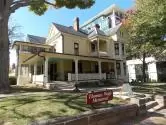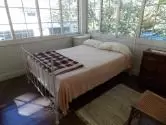Looking In Your Own Backyard

It has often been said that some of our most memorable little journeys take place in our own backyard.
Asheville has long been known as an Arts and Crafts city, from the time the local mountaineers made rustic furniture and hand-turned stoneware to early 20th century artisans and manual arts enterprises to the celebration of the Arts and Crafts revival through the Southern Highland Craft Guild and the national Arts and Crafts Conference at the 1913 Grove Park Inn.
But the Asheville area has a literary legacy as well, including such notables as Thomas Wolfe, O. Henry, Carl Sandburg, and F. Scott Fitzgerald, and so it was that Leigh Ann and I took an hour on Friday afternoon to re-visit the boyhood home of Tom Wolfe, a designated historic landmark since 1948.
Made famous in Look Homeward, Angel as “Dixieland,” the rambling Queen Anne boarding house that his mother ran for nearly forty years, all the while raising six small children among the scabby assortment of invalids and seedy traveling salesmen, has been preserved and restored to look much as it did when Tom was growing up.
Julia Wolfe opened her boarding house, formally known as the Old Kentucky Home (named by a previous owner from Lexington), in 1906, and immediately began dividing large bedrooms and porches into smaller sleeping quarters, and building on small additions until she could sleep as many as 30 people at one time. As you might expect of someone as miserly as she was, Julia Wolfe filled the rooms with the cheapest, most available furnishings. What wasn’t picked up for a few dollars at a local sale, she ordered through one of the national mail order catalogs.

Tom Wolfe died a tragic and horrible death from tuberculosis of the brain at age 38; Julia Wolfe outlived her son by seven years, dying in 1945. The house was almost immediately recognized as a significant piece of Asheville history, so the furnishings remained intact. Those that are not original have been replaced by appropriate antique furnishings.
As a result, the furnishings of the house read like a jumbled history of American furniture styles, beginning in the front hallway where a respectable Arts and Crafts oak settle and matching armchair sit uncomfortably next to an unmatched pair of Victorian walnut parlor tables with polished marble tops. Peek through the doorway into the dining room and you will see more than a dozen pressed-back oak chairs, plus a couple of fancy oak china cabinets and sideboards.
The house suffered a debilitating fire, set by an unknown arson in 1998. Fortunately, only a few pieces of significant furniture were completely destroyed, but nearly all suffered smoke and water damage. When it reopened in 2000 after a $3 million renovation, the house looked, as our tour guide pointed out, even better than it did when Tom was growing up.
The guided tour could not have been better: only seven in our group, the guide was personable and knowledgeable, photographs were allowed, and we could walk freely through nearly every room in the house. In short, it was both delightful and insightful.
If you are coming to Asheville in February for the Arts and Crafts Conference, don’t forget that the Biltmore Estate is not the only house worth seeing. The Thomas Wolfe Visitor Center and Home is located right beside the Renaissance Hotel in downtown Asheville, and the tour only costs five dollars.
And you don’t have to have read Look Homeward, Angel to appreciate this opportunity to step back into the Arts and Crafts era and to see how most typical homes of that time probably looked.

Until next Monday,
Have a great week!
Bruce
For more information, please go to http://www.WolfeMemorial.com.
